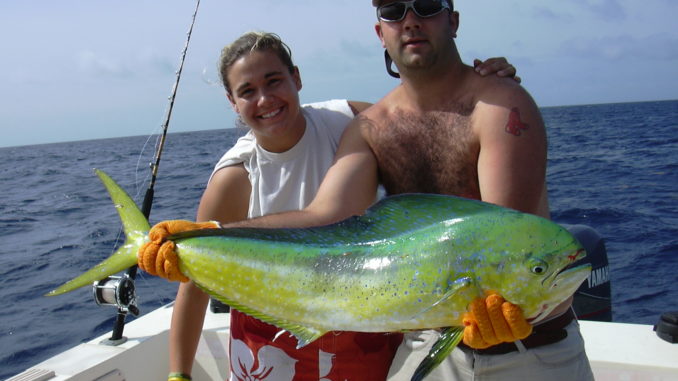
Few organisms in the ocean can match the fast life cycle of the dolphin fish, coryphaena hippurus. Dolphin reach sexual maturity at four to five months, where it takes a king mackerel three years to spawn. The world-record dolphin, 87 pounds was believed to be slightly less than five years old. By comparison, the world-record king mackerel, a 93-pound fish, was thought to be closer to 25 years old.
Dolphin are found in all sub-tropical and tropical oceans, wherever the water temperature and bait concentrations support them. Gaffer-sized fish — big enough to require gaffing — have been caught of North Carolina’s coast year-round, but it is the spring migration that brings the bulk of the fish to those Gulf Stream waters. Wave after wave of fish make their way through the Straits of Florida and come up the beach with the Gulf Stream, using sargassum mats for both cover and food. Juvenile dolphin feed heavily on the larvae and invertebrates found drifting sargassum weed, then switch their focus to the small fish that drift with the grass as well.
Dolphin are notorious cannibals, and adult dolphin are undoubtedly the biggest menace to juvenile dolphin. Perhaps this is why the green/chartreuse lure color combination is so loved by fishermen, it gives their bait the same color pattern as a juvenile dolphin. Far less than one percent of all dolphin fry make it to adulthood, but the sheer number of these fish means there are still plenty of gaffer-sized fish for anglers to target each year.
Dolphin prefer water temperatures from 70 to 77 degrees but can tolerate slightly cooler or warmer water. When the water inshore of the Gulf Stream is cooler in the spring, the concentration of these fish will stay with the warmer water, making them easier to target. As the inshore water warms, many will move inshore and take up what appears to be residence in shallower water, where they will stay for the summer. Many of these inshore fishermen are caught by fishermen targeting king mackerel, slow-trolling live or dead bait in the summer. The dolphin that stay offshore will continue to make their way up the coast, going as far as the North East canyons. Those that make it all the way to New England are caught in the middle to late summer with techniques similar to those North Carolina anglers use.
Only fishermen in Florida catch more dolphin than North Carolina fishermen. Most of these fish are caught by recreational and charter-boat anglers, though there is increasing commercial pressure on dolphin, specifically from long lines. Last year was the first that the commercial dolphin fishery met its allocation and was closed. Commercial fishermen get 10 percent of the annual catch limit, 13,810,361 pounds for 2016.
Recreational anglers in North Carolina are limited to 10 fish per day, up to 60 vessel with no size limit. The roots of the 10/60 rule began with the charter fleet in Hatteras in the 1970s. Captains limited their parties to prevent the waste of fish, well before any government entity thought to put conservation measures on one of the ocean’s most-renewable resources. Dolphin will probably become more regulated in the future, but in the meantime, they are a healthy and prolific stock, which has neither been overfished nor experienced overfishing. When the conditions are there to get offshore, head out to the deep and score big.



